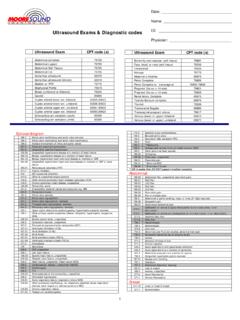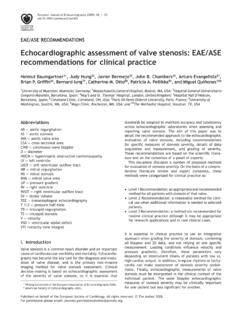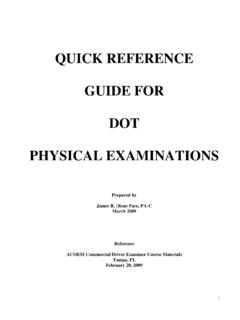Transcription of Syncope: Evaluation and Differential Diagnosis
1 March 1, 2017 Volume 95, Number 5 American Family Physician 303 Syncope is an abrupt and transient loss of consciousness caused by cerebral hypoperfusion. It accounts for 1% to of emergency department visits, resulting in high hospital admission rates and significant medical costs. Syncope is classified as neurally mediated, cardiac, and orthostatic hypotension. Neurally mediated syncope is the most common type and has a benign course, whereas cardiac syncope is associated with increased morbidity and mortality. Patients with presyncope have similar prognoses to those with syncope and should undergo a similar Evaluation . A standard-ized approach to syncope Evaluation reduces hospital admissions and medical costs, and increases diagnostic accu-racy.
2 The initial assessment for all patients presenting with syncope includes a detailed history, physical examination, and electrocardiography. The initial Evaluation may diagnose up to 50% of patients and allows immediate short-term risk stratification. Laboratory testing and neuroimaging have a low diagnostic yield and should be ordered only if clin-ically indicated. Several comparable clinical decision rules can be used to assess the short-term risk of death and the need for hospital admission. Low-risk patients with a single episode of syncope can often be reassured with no further investigation. High-risk patients with cardiovascular or structural heart disease, history concerning for arrhythmia, abnormal electrocardiographic findings, or severe comorbidities should be admitted to the hospital for further evalu-ation.
3 In cases of unexplained syncope, provocative testing and prolonged electrocardiographic monitoring strategies can be diagnostic. The treatment of neurally mediated and orthostatic hypotension syncope is largely supportive, although severe cases may require pharmacotherapy. Cardiac syncope may require cardiac device placement or abla-tion. (Am Fam Physician. 2017;95(5):303 -312. Copyright 2017 American Academy of Family Physicians.)Syncope: Evaluation and Differential DiagnosisLLOYD A. RUNSER, MD, MPH; ROBERT L. GAUER, MD; and ALEX HOUSER, DO Womack Army Medical Center, Fort Bragg, North CarolinaSyncope is a sudden, brief, and tran-sient loss of consciousness caused by cerebral Other nontraumatic loss of consciousness syndromes include seizures, cataplexy, met-abolic disorders, acute intoxications, verte-brobasilar insufficiency, transient ischemic attack, cerebrovascular accident, and psy-chogenic ,3 Syncope accounts for 1% to of all emergency department visits, 250,000 annual hospital admissions, and a median hospital cost of $8.
4 5 Approximately 40% of the population will experience a syncopal episode in their lifetimes, and 30% to 50% will be admitted to the hospital for further ,7 The etiology is unex-plained in up to one-third of syncope is associated with seri-ous risks, short-term mortality is low ( , at 10 days and at 30 days). At one year, the mortality rate is ; one-third of these are attributed to cardiovascu-lar causes. Approximately 25% of patients with syncope will experience another event within two ,9 Historically, neurally mediated and orthostatic hypotension syn-cope have not conferred an increased risk of death10; however, in a recent study, healthy adults with a Diagnosis of syncope had higher rates of all-cause mor t a l it y, rec u r-rent syncope, cardiovascular events, and pacemaker or implantable cardioverter-defibrillator placement compared with matched controls.
5 Patients 44 to 75 years of age had the highest ,12 Management of syncope remains a chal-lenge, particularly in identifying patients with potentially life-threatening etiolo-gies. Lack of physician knowledge, a desire to reassure the patient or clinician, and the fear of medicolegal ramifications result in overuse of diagnostic A standardized approach for evaluating patients with syn-cope reduces admissions, hospital costs, and number of tests performed, and increases accuracy of Only 10% to 15% of patients will remain undiagnosed after a comprehensive Evaluation using current ,16 More online at This clinical content conforms to AAFP criteria for continuing medical education (CME).
6 See CME Quiz Questions on page disclosure: No rel-evant financial affiliations. Patient information: A handout on this topic is available at from the American Family Physician website at Copyright 2017 American Academy of Family Physicians. For the private, noncom-mercial use of one individual user of the website. All other rights reserved. Contact for copyright questions and/or permission American Family Physician Volume 95, Number 5 March 1, 2017 Classification and EtiologySyncope is classified as cardiac, neurally mediated (reflex), and orthostatic hypotension (Ta b l e 1).1,17 The dif-ferential Diagnosis should include nontraumatic causes of transient loss of consciousness.
7 Rare causes include subclavian steal syndrome, pulmonary embolism, acute myocardial infarction, acute aortic dissection, leaking aortic aneurysm, subarachnoid hemorrhage, and cardiac ,3 Neurally mediated syncope is the most common type, comprising approximately 45% of ,10,18 It can be vasovagal, situational, or secondary to carotid sinus hypersensitivity. The pathophysiology is complex, con-sisting of an interaction between autonomic systems paradoxically favoring parasympathetic or vagal tone, which causes bradycardia and syncope occurs in approximately 20% of syncope presentations. It is most often caused by an arrhythmia, and less often by a structural cardiac abnormality.
8 In a prospective cohort study, patients with cardiac syncope had a twofold increase in mortality over 17 The presence of cardiovascular disease predicts a cardiac eti-ology of syncope with 85% to 94% sensitiv-ity and 64% to 83% hypotension syncope has an incidence of approximately 10% and is typically characterized by posturally induced hypotension, most often related to impaired increase in systemic vascu-lar resistance. Associated factors include medication effects, volume depletion, acute hemorrhage, and autonomic dysfunction. Postural tachycardia syndrome is the most prevalent form of orthostatic intolerance, affecting approximately 500,000 persons in the United States.
9 Younger adults, predominantly women who report symptoms of postural presyncope, are more likely to have this Presyncope is poorly studied, and the true incidence is unknown. A study of 881 patients presenting to the emergency department with presyncope showed a 30-day risk of serious outcomes of 5% and a mortal-ity rate of Emergency physicians had difficulty stratifying patients at increased risk of adverse outcomes, regardless of presumed etiology. A prospective observa-tional study (n = 244) compared adverse outcomes and SORT: KEY RECOMMENDATIONS FOR PRACTICEC linical recommendationEvidence ratingReferencesPatients who present with presyncope should be evaluated similarly to those who present with , 21 Patients with syncope and evidence of congestive heart failure or structural heart disease, abnormal electrocardiographic findings, or a family history of sudden death should be admitted to the hospital for emergent , 25, 27, 29 Patients presenting with syncope should have orthostatic blood pressure measurements and standard 12-lead , 2, 25, 27, 29 Laboratory and imaging studies should be ordered for patients with syncope only if clinically indicated by the history and physical.
10 27, 39, 40, 42, 43, 50, 51 Implantable loop recorders increase diagnostic yield, reduce time to Diagnosis , and are cost-effective for suspected cardiac syncope and unexplained , 39, 44-48 Patients with syncope who are at low risk of adverse events ( , those with symptoms consistent with vasovagal or orthostatic hypotension syncope, no history of heart disease, no family history of sudden cardiac death, and normal electrocardiographic findings) may be safely followed without further intervention or treatment. C1, 25, 27, 29A = consistent, good-quality patient-oriented evidence; B = inconsistent or limited-quality patient-oriented evidence; C = consensus, disease-oriented evidence, usual practice, expert opinion, or case series.


















